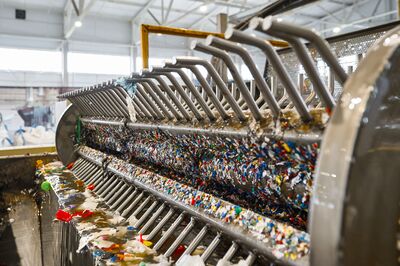Plastic Recycling : "Mechanical recycling is and shall remain the preferred recycling solution"

What are the advantages of mechanical recycling over chemical recycling?
Mechanical recycling is a mature technology, benefiting from a structured upstream and downstream value chain, with hundreds of plants, a very low GHG footprint (70 to 80% lower than virgin, mostly from electricity, quite easy to even further decarbonate) together with a good plastic to plastic yield (#80-85%).
Depending on the feedstock and process implemented, it is important to emphasise the fact that it is possible to produce the highest grades of circular polymers, even Food Grade (FG), on wide volumes for FG r-PET but scarcer quantities for FG r-PE or r-PP. We should also never forget that mechanical recycling is a technology in constant evolution and improvement. Indeed, thanks to the development of circular loops for “green to green” bottles or “tray to tray” in several plants in operation, what was not possible yesterday, becomes possible today.
Among the various chemical recycling processes (Dissolution, Depolymerisation and Thermal cracking ~ Pyrolysis), all show a much lower maturity (only a handful of industrial projects over the world) and they have a severely worse GHG footprint. By order of maturity, Pyrolysis applied on "Plastic to plastic" shows, as of today, a GHG footprint higher than virgin, and a very poor material recycling yield (30 to 40% max after vapocracking), which makes the promise of "infinite recycling" an illusion.
Dissolution and Depolymerisation announce GHG footprints significantly lower than virgin (-5 to -30%), remaining however in any case much higher than mechanical recycling (x2 or x3). Depolymerisation is reserved to some specific polymers only (mostly PET and PS). The expected yields look quite good (around 80%). Dissolution may benefit from an excellent material yield (#95%) but looks to require a very pure feedstock. As such it can be considered as a purification post-treatment after mechanical recycling.
Want to stay up-to-date on our content? Subscribe to our newsletters!
Do you see those two technologies as rivals?
Those technologies have not to be rivals but complement each other to tackle the double challenge of circularity and decarbonisation. Public bodies should set the rules so that direct competition does not happen: Mechanical recycling is and shall remain the preferred recycling solution as it is by far the most efficient when applicable and it has demonstrated to be the most beneficial to climate change mitigation.
Thermal cracking processes can be a good way to escape incineration of plastics when there is no other option. In such a case, the recycling value chain has to finance the extraction and sorting of the plastics, and to allow the part eligible to mechanical recycling to get back to this preferred recycling solution. Mixed refusals from sorting sites also represent good candidates for a valorisation by pyrolysis.

Thus it can be a good transitional solution to the decarbonisation of the Waste-to-Energy plants, providing some more circularity and resource saving, but the near future looks very far from the promise of a switch of the plastic industry from linear to circular.
A wide field of development of the depolymerisation can be seen to address the challenge of textile recycling (polyesters). Currently, the depolymerisation projects are more targeting trays or coloured bottles despite nascent mechanical recycling routes should reveal a better GHG balance for those streams.
Dissolution offers a possibility to expand the field of production of food grade circular polyolefins from non eligible feedstocks, as a polishing step in the downstream of mechanical recycling for the applications willing to add a premium for specific parameters.
Mechanical recycling is and shall remain the preferred recycling solution as it is by far the most efficient when applicable and it has demonstrated to be the most beneficial to climate change mitigation.
How important is mixed waste sorting/pre-sorting for mechanical recycling?
In combination with the sorting behaviours at source which shall be promoted and incentivised at maximum, sorting/presorting of mixed waste streams is a key success factor to increase the availability of segregated streams allowing the development of a real circularity. Separate collection shall remain the preferred option for household collection, allowing for the massification of the sorting steps in MRFs (Material Recovery Facility) and PRFs (Plastic Recycling Facility). This chain is able to efficiently create the streams that are needed to serve the appetite from end users for qualitative and safe products made from circular polymers.
The number of streams remains limited by nature at the beginning of the loop, with a progressive concentration of consistent qualities over the sorting steps. The expertise of customer-centric and application-driven compounding to fine-tune the desired grades of circular polymers allows then to close the loop. This is exactly the spirit of the PlastiLoop brand with its range of “ready to use circular polymers” developed by Veolia. For the part of plastic waste which may not be segregated at source, then a "mainstream" sorting may be needed to extract plastics (most of the fossil portion) from the residual waste. This step shall catch and properly allocate plastic waste eligible for both mechanical and chemical recycling. It shall also deal with the production of a valuable organic fraction and an "as low as possible" residual waste fraction which will most probably remain. As a matter of fact, the cost for such a "mining-like" step will be much higher than noncircular end-of-life solutions like landfilling or Waste-to-Energy. It shall be financed by the upstream of the industry through EPR schemes (Extended Producer Responsibility) as well as by the value given to the feedstock for chemical recycling.
How do you see the future of plastic recycling?
Beyond recycling processes and individual "sorting behaviours", the key success factor for a real circularity of plastics stays definitely with the collective responsibility of a proper eco-design. Reduction of useless plastics or poorly recyclable waste, ban of unsortable mixed plastics, selection of proper additives, pigments or glues... here is the third pillar of a circular economy of plastics. We should even say it is the top first one. Public bodies have the duty to influence brands and converters in design for recycling with harmonised recyclability standards over countries and continents, as we see the EU PPWD (Packaging and Packaging Waste Directive) pushing in that direction.
The future of plastic recycling will then be a combination of mechanical processes in combination with the contribution of Chemical recycling processes. Mechanical recycling will further deliver enhanced performance on quality and yield, including new solutions for safe applications on cosmetics and food grade applications (monomaterial multilayer, nano-coating, ...). In addition, the contribution of chemical recycling can be to value the remaining "non recyclable streams" or offer highly polished ones, with the challenge of optimising the heavy GHG footprint of those processes. In addition, due to a global recycling yield that will probably never exceed 70%, there will always be a need for low GHG virgin material.
For more information read our article here!
Beyond recycling processes and individual "sorting behaviours", the key success factor for a real circularity of plastics stays definitely with the collective responsibility of a proper eco-design.
How important are legal frameworks such as recycled content targets, EPR schemes…?
In conclusion, aside from the powerful driver of brands’ claims and customers' appetite for sustainability, public bodies and legal frameworks play a key role to set the rules and conditions of an economically viable circular economy of plastics. They are the key players to enforce the proper consideration of the negative externalities for a linear economy of plastics (pollution, GHG, resources), and make sure a truly circular system is promoted. This challenge deserves efforts for a tremendous change of paradigma. They have several levers of action to skirt the illusion of a possible "business as usual" future:
- ban useless applications of plastics (as of any material) and promote reduce or reuse wherever possible,
- promote collective responsibility for eco-design with harmonised rules for recyclability (based on mechanical recycling criteria) and eco-modulation fees or taxes,
- push for the creation of non profit EPRs driven by non financial performance KPI, financing agile, innovative and long-term investments from operators.
- create traction on the market thanks to the implementation of ambitious recycle content obligations over the whole bench of industries and,
- ensure the proper traceability and credibility of recycled content claims (proportional allocation in case mass balance is needed).
An ambitious program where all stakeholders have to contribute so as to impact and curve the plastic challenge toward circularity.

